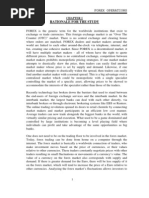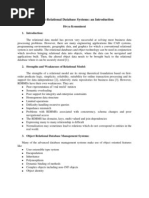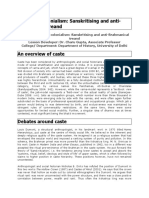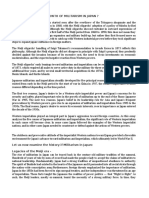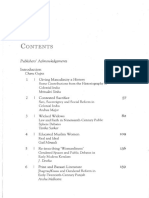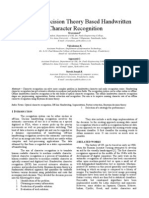0 ratings0% found this document useful (0 votes)
161 viewsHistory: (For Under Graduate Student)
History: (For Under Graduate Student)
Uploaded by
zeba abbasThe document discusses the historiography of the early medieval period in India from 600-1300 CE. It explores debates around how to characterize the political and social changes during this transition period, including whether it can be considered a period of feudalism. Key points of debate include whether there was decentralization and the emergence of feudal land grants and hierarchies, or alternative processes of state formation, peasantization, and cultural integration. The discussion centers on the work of historians like R.S. Sharma, B.D. Chattopadhyaya, and others who have different views on the nature and causes of changes during this period in Indian history.
Copyright:
© All Rights Reserved
Available Formats
Download as PDF, TXT or read online from Scribd
History: (For Under Graduate Student)
History: (For Under Graduate Student)
Uploaded by
zeba abbas0 ratings0% found this document useful (0 votes)
161 views15 pagesThe document discusses the historiography of the early medieval period in India from 600-1300 CE. It explores debates around how to characterize the political and social changes during this transition period, including whether it can be considered a period of feudalism. Key points of debate include whether there was decentralization and the emergence of feudal land grants and hierarchies, or alternative processes of state formation, peasantization, and cultural integration. The discussion centers on the work of historians like R.S. Sharma, B.D. Chattopadhyaya, and others who have different views on the nature and causes of changes during this period in Indian history.
Original Description:
read
Original Title
History
Copyright
© © All Rights Reserved
Available Formats
PDF, TXT or read online from Scribd
Share this document
Did you find this document useful?
Is this content inappropriate?
The document discusses the historiography of the early medieval period in India from 600-1300 CE. It explores debates around how to characterize the political and social changes during this transition period, including whether it can be considered a period of feudalism. Key points of debate include whether there was decentralization and the emergence of feudal land grants and hierarchies, or alternative processes of state formation, peasantization, and cultural integration. The discussion centers on the work of historians like R.S. Sharma, B.D. Chattopadhyaya, and others who have different views on the nature and causes of changes during this period in Indian history.
Copyright:
© All Rights Reserved
Available Formats
Download as PDF, TXT or read online from Scribd
Download as pdf or txt
0 ratings0% found this document useful (0 votes)
161 views15 pagesHistory: (For Under Graduate Student)
History: (For Under Graduate Student)
Uploaded by
zeba abbasThe document discusses the historiography of the early medieval period in India from 600-1300 CE. It explores debates around how to characterize the political and social changes during this transition period, including whether it can be considered a period of feudalism. Key points of debate include whether there was decentralization and the emergence of feudal land grants and hierarchies, or alternative processes of state formation, peasantization, and cultural integration. The discussion centers on the work of historians like R.S. Sharma, B.D. Chattopadhyaya, and others who have different views on the nature and causes of changes during this period in Indian history.
Copyright:
© All Rights Reserved
Available Formats
Download as PDF, TXT or read online from Scribd
Download as pdf or txt
You are on page 1of 15
History of India Page 1 of 15
HISTORY
Subject : History
(For under graduate student)
Paper No. : Paper - II
History of India
Topic No. & Title : Topic - 1
Early Medieval Period:
Historiography
Lecture No. & Title : Lecture - 1
Early Medieval Period: Historiography
and Debates
Early Medieval Period: Historiography and Debates
Introduction
The early medieval period spanning from c.600CE to 1300CE
is to be situated between the early historical and medieval.
Historians are unanimous on the fact that this phase in Indian
history had a distinct identity and as such differed from the
preceding early historical and succeeding medieval. This in
turn brings home the presence of the elements of change and
continuity in Indian history. It is identified as a phase in the
transition to the medieval. Perception of a unilinear and
History of India Page 2 of 15
uniform pattern of historical development is challenged.
Changes are identified not merely in dynastic upheavals but
are also located in socio-economic, political and cultural
conditions. One of the richest historical debates i.e. the
feudalism debate revolve around this period. It is dubbed by
B.D.Chattopadhyaya as a period which long remained a much
maligned period of Indian history. This period is seen in
Marxist historiography as a breakdown of the civilizational
matrix of early historic India. Breakdown is envisaged in
terms of social crises. Another issue that saw much
disagreement among historians relates to the nature of the
polity in the period. Different genres of historians agree that
there was a shift in the nature of polity of the post 600CE
phase from that of the pre 600CE days but the causative
factors responsible for this changing scenario are not
unanimously identified.
Marxist scholars like R.S.Sharma, BNS Yadav and the likes
view early medieval polity as one of decentralization and
disintegration in sharp contrast to early historical polity which
encouraged forces of centripetality. According to this
historiography decentralization and disintegration is to be
posited against the backdrop of the emergence and
crystallization of Indian feudalism. B.D.Chattopadhyaya does
not however see the making of early medieval India in terms
History of India Page 3 of 15
of the crisis of a pre-existent, pan Indian social order. He is
not in favour of perceiving early medieval phase only in terms
of feudal formation. On the other hand he identifies three
major processes which were operative throughout Indian
history viz a) the expansion of state society through the
process of local state formation b) peasantization of tribe and
caste formation and c) cult appropriation and integration.
Feudalism Debate:
It will be in order to briefly discuss the contours of the
feudalism debate that has shaped up in Indian history. The
concept of feudalism is a borrowing from European
historiography. Combined with the notion of social formation
it is the seminal empirical writings of Henri Pirenne and Marc
Bloch which have perhaps served as models for those who
began seriously working out empirical validation of feudalism
as a social formation in Indian history.
The first assimilation of „feudalism‟ in the Indian context
occurred at the hands of Col. James Todd, the celebrated
compiler of the annals of Rajasthan‟s history in the early part
of the nineteenth century. For Todd, as for most European
historians of his time in Europe, lord-vassal relationship
constituted the core of feudalism. The lord in medieval Europe
looked after the security and subsistence of his vassals and
History of India Page 4 of 15
they in turn rendered military and other services to the lord.
A sense of loyalty also tied the vassal to the lord in
perpetuity. For him the pattern was replicated in Rajasthan..
D D Kosmabi gave feudalism a significant place in the context
of socio-economic history. He conceptualised the growth of
feudalism in Indian history as a two-way process: from above
and from below in his landmark book, An Introduction to the
Study of Indian History, first published in 1956. From above
the feudal structure was created by the state granting land
and rights to officials and Brahmins; from below many
individuals and small groups rose from the village levels of
power to become landlords and vassals of the kings.
The hierarchical structure of society, as opined by
R.S.Sharma, was the political fall out of the deep seated
social crisis, better known as Kaliyuga crisis in and around 4th
century CE. This crisis is reflected in the ability of rulers to
exercise their coercive authority (danda) and to collect
resources by revenue measures. The political authority
therefore took recourse to the issuance of land grants to
religious donees-largely brahmanas- who were not only
endowed with landed wealth but also with administrative and
judicial rights. The donees therefore emerged as landed
intermediaries between the ruler and the actual peasantry.
The landed intermediaries, thus, grew as local power base.
History of India Page 5 of 15
Subsequent to religious donees, secular donees emerged, as
dearth of metallic courrency, according to Sharma, forced the
ruler to assign lands to state officials in lieu of cash. He
visualised the decline of India‟s long distance trade with
various parts of the world after the fall of the Guptas;
urbanisation also suffered in consequence, resulting in the
economy‟s ruralisation. Along with land, the state also gave
away more and more rights over the cultivating peasants to
this new class of „intermediaries‟. The increasing subjection of
the peasants to the intermediaries reduced them to the level
of serfs, their counterparts in medieval Europe. This process
lasted until about the eleventh century when the revival of
trade reopened the process of urbanisation. The decline of
feudalism is suggested in this revival, although R S Sharma
does not go into this aspect in as much detail. The one
element that was missing in this picture was the Indian
counterpart of the Arab invasion of Europe; however,
Professor B N S Yadava, another eminent proponent of the
Indian feudalism thesis, drew attention to the Hun invasions
of India which almost coincided with the beginning of the rise
of feudalism here. The oppressive feudal system in Europe
had resulted in massive rebellions of the peasantry in Europe;
in India R S Sharma suggested that the Kaivartya rebellion in
Bengal was an evidence of peasant protest. B N S Yadava and
D N Jha stood firmly by the feudalism thesis.
History of India Page 6 of 15
The feudal formulation was based on the basis of land grants
alone and any such formulation is open to question. Thus, it
has been effectively questioned whether the transfer of
revenue to the donee would at all amount to the corrosion of
the rulers‟ economic prerogatives. D.C.Sircar criticized the
Marxist historians for their inability to distinguish landlordism
and tenancy in India from feudalism. Harbans Mukhia, a
committed practitioner of Marxist history writing in an address
entitled „Was There Feudalism in Indian History?‟ questioned
the Indian feudalism thesis at the theoretical plane and then
at the empirical level by comparing the medieval Indian
scenario with medieval Europe. The empirical basis of the
questioning of Indian feudalism in a comparison between the
histories of medieval Western Europe and medieval India,
pursued at three levels: the ecological conditions, the
technology available and the social organisation of forms of
labour use in agriculture in the two regions. With this
intervention, the debate was no longer confined to
feudalism/trade dichotomy..
While the debate critically examined the theoretical
proposition of the universality of the concept of feudalism or
otherwise – with each historian taking his own independent
position – on the question of Indian historical evidence, R S
Sharma, who was chiefly under attack, reconsidered some of
History of India Page 7 of 15
his earlier positions and greatly refined his thesis of Indian
feudalism, even as he defended it vigorously and elegantly in
a paper, „How Feudal was Indian Feudalism?‟ He had been
criticised for looking at the rise of feudalism in India entirely
as a consequence of state action in transferring land to the
intermediaries. He modified it and expanded its scope to look
at feudalism as an economic formation which evolved out of
economic and social crises in society, signifying in the minds
of the people the beginning of the Kaliyuga, rather than
entirely as the consequence of state action. This enriched his
argument considerably. R S Sharma has lately turned his
attention to the ideological and cultural aspects of the feudal
society; and included some new themes such as „The Feudal
Mind‟, where he explores such problems as the reflection of
feudal hierarchies in art and architecture, the ideas of
gratitude and loyalty as ideological props of feudal society,
etc. D.N.Jha, in an edited volume, The Feudal Order‟, has
included papers exploring the cultural and ideological
dimensions of what he calls the feudal order, itself a
comprehensive term. One of the major dimensions so
explored is that of religion, especially popular religion or
Bhakti, both in north and south India and the growth of
India‟s regional cultures and languages. Even as most
scholars have seen the rise of the Bhakti cults as a popular
protest against the domination of Brahmanical orthodoxy, the
History of India Page 8 of 15
proponents of feudalism see these as buttresses of
Brahmanical domination by virtue of the ideology of total
surrender, subjection and loyalty to a deity. This surrender
and loyalty could easily be transferred on to the feudal lord
and master.
Several historians criticized the notion of the decline of trade
and urban centres. D N Jha had criticized R S Sharma for
relying too heavily on the absence of long distance external
trade as the cause of the rise of feudalism in India.. B D
Chattopadhyay has shown that there are enough evidence to
show urban development and not decay in early medieval
India.to have happened at least a century earlier. Ranabir
Chakravarti has brought forward ample evidence of
flourishing trade, different categories of merchants and
market centres in the concerned period. The monetary
anaemia thesis, fundamental to the formulation of Indian
feudalism, has also been put under severe strain by recent
researches of B D Chattopadhyay and B N Mukherjee.and
John S Deyell who seriously undermined the assumption of
the scarcity of money.
Debate on the nature of polity
With regard to the difference of opinion regarding the nature
of polity, the multiplicity of regional powers distinguished the
History of India Page 9 of 15
polity of early medieval India from the situation prevailing in
the pre 600 CE days. The causative factors responsible for
this changing scenario are not unanimously identified. At
present there exist at least three different structural models
for the early medieval Indian kingdoms.
i) the conventional model of a rather unitary, centrally
organized kingdom with a strong central bureaucracy
ii) the Indian Feudalism model of decentralized feudal
states
iii) the model of a segmentary state
These three models depict the early medieval Indian kingdom
either as a strong and centralized state or as one of
decentralization and disintegration or as a state which has not
yet reached the position of a strong and centralized state
though it did have some of its characteristics in its core
around the capital. According to the conception of Indian
feudalism, state formation after the Gupta period had a
decidedly negative character, since the many local kingdoms
and principalities had developed at the cost of the former
larger political entities. The processes which worked towards
administrative decentralization are essentially seen to have
derived from a) the practice of making land grants along with
administrative privileges.b)the break down of the state‟s
monopoly over the army. The understanding of the feudal
History of India Page 10 of 15
political set up is also linked up with the changing socio-
economic and cultural situations in the early medieval times.
The puranic narration of the weakening of the political
authority , non-observation of the varnasrama dharma and
other things is taken to have represented a deep-seated
social crisis. The political fall out of the crisis is seen in the
inability of the rulers to exercise their coercive authority
(danda) and to collect resources by revenue measures.
The hall mark of the early medieval polity is placed in the
samanta system. The term samanta originally denoted a
neighbouring king. But gradually it assumed the sense of a
vassal. No less than seven grades of samantas are
represented in the Harshacharita. The sharp changes which
the term samanta went through over time reflects
fundamental changes in Indian polity, reinforcing the image of
a hierarchical political structure. The evidence of the growing
number and influence of the samantas in early medieval
polity is seen as both the cause and effect of the centralized
political power. The feudal polity is symptomatic of the
absence of a paramount power and synonymous with political
fragmentation. The construction of feudal polity would
suggest that it is primarily based on data pertaining to north
India. The proponents of Indian Feudalism, however, consider
this to be an all India phenomenon, with regional variations.
History of India Page 11 of 15
A major disadvantage of the theory of Indian feudalism is the
preponderance of its conceptual framework of decentralization
and political fragmentation. The period which followed the
disappearance of the Gupta empire in the 6th century CE can
be interpreted as a period of political fragmentation in North
India and parts of Central India. But this fragmentation
certainly was not caused through land donations either to
secular or religious donees. A structural interpretation of the
early medieval period reveals that this period of North Indian
decentralization coincided with a very intensive process of
state formation on the local sub regional and regional level in
some part of northern India, many parts of central India and
in most parts of southern India.. It was during this time that
a process of indigenous state formation took place in many
parts of India.
A major trait of the individuality of the early medieval south
Indian polity can be seen in the vital local self bodies of the
Pallava and the Chola regime. The local self bodies made their
presence strongly felt in the political life within a monarchical
set up. The general tendency in a monarchical set up is to
undermine the vitality of local self-bodies and to wipe out
their existence. N.K. Sastri opined that the Chola monarchy
was an intelligent juxtaposition of an extremely powerful
History of India Page 12 of 15
monarchy at the apex level and the overwhelming presence
of local self bodies at the villages.
This proposition has been negated by an alternative
explanation of the phenomenal presence of local self bodies in
south Indian polity. The theoretical model known as the
Segmentary State theory, also questions the inadequacy of
the feudal model as a tool to explain the prevailing polity in
south India. Inspired by the studies of East Africal Alur society
by A. Southhall, Burton Stein located the segmentary polity
from Pallava times. The Segmentary theory view the king as
having enjoyed only limited territorial sovereignty. The
element of centrality existed only in the core area even where
the presence of quasi-autonomous foci of administration was
tolerated by the Cholas. The real foci of power are suggested
to have been the locality level centers or nadus. Stein
distinguishes sharply between actual political control on one
side and ritual sovereignty on the other. All the centers of the
segmentary state do exercise actual political control over their
own part or segment, but only one center the primary center
of the ruling dynasty has the primacy of extending ritual
sovereignty beyond its own borders. The absence of an
organized bureaucracy forced the Chola monarch to fall back
instead on ritual sovereignty in which the position of the ruler
required to be legitimized and validated by the brahmana
History of India Page 13 of 15
priest. Stein confines ritual sovereignty mainly to the state
cult exemplified in the royal Siva cult of Rajaraja‟s
Rajarajesvara temple at Tanjore. The construction of massive
temples is interpreted not as a mark of the stupendous power
of the Chola rule, but as a symptom of political uncertainties,
the king being the principal ritualist. Moreover the inscriptions
are also looked at by Stein as a clear evidence of ritual
sovereignty. Hermann Kulke has questioned Stein‟s concept
of ritual sovereignty. According to him in a traditional society,
particularly in India, ritual sovereignty seems to be an
integral part and sometimes even a pace maker of political
power. These inscriptions were documents of a systematic
ritual policy which was as much a part of the general „power
policy‟ as, for instance, economic or military policies.
A key element of the segmentary state theory was also the
so-called Brahmana-peasant alliance at the nadu. This does
not have any parallel in Indian history. On the contrary, the
peasant is always known to have been exploited by the
Brahmana and Kshatriya combination. The creation of vala
nadu-larger than the nadu but smaller than a mandalam, by
Rajaraja and Kulottunga I is an indicator of the administrative
innovations and hence directs intervention by Chola Central
authority.
History of India Page 14 of 15
The feudal polity and the segmentary state theory highlight
the traits of disintegration and fragmentation as opposed to a
centralized state structure. According to B.D.
Chattopadhyaya, the segmentary state model or the concept
of ritual sovereignty cannot in fact resolve the problem of the
political basis of integration since a rigid use of the
segmentary state concept relegates the different foci of power
to the periphery and does not really see them as components
of state structure. The phenomenon of different foci of power
was not peculiarly south Indian but cut across all major
political structures of the early medieval period.
These models have been challenged by a group of scholars
clubbed together as “non aligned historians” by Hermann
Kulke. This non-aligned group is reluctant to accept any
models. On the other hand their focus is on structural
developments and changes within a given state system.
According to them the multiplicity of local and regional power
is the result of the extension of monarchical state society into
areas and communities tribal, non-monarchical polity. In their
opinion early medieval polity is perceived as an „integrative
polity‟. The integration of the tribes in the jati system was
further given a momentum by the simultaneous absorption of
tribal/folk cults into the sectarian Brahmanical Bhakti cults.
Bhakti, from the stand point of the state could be an
History of India Page 15 of 15
instrument of integration, much more effectively than
Dharmasastra oriented norms. Thus modes of integration
formed an important aspect of state formation in early
medieval India.
You might also like
- OceanofPDF - Com Zeus and Hera - Katee RobertDocument12 pagesOceanofPDF - Com Zeus and Hera - Katee RobertLucie OrlovskáNo ratings yet
- Contemporary Hong Kong Government and Politics - CompressDocument415 pagesContemporary Hong Kong Government and Politics - CompresschanchunsumbrianNo ratings yet
- SyllabusDocument5 pagesSyllabusBalbeer SinghNo ratings yet
- Ed Lapiz ProfileDocument3 pagesEd Lapiz ProfileDioscoro MacalamNo ratings yet
- Peasants - Eric R. WolfDocument128 pagesPeasants - Eric R. WolfVinícius Domingos100% (2)
- (International Political Economy) Godfrey Baldacchino (Eds.) - The Political Economy of Divided Islands - Unified Geographies, Multiple Polities-Palgrave Macmillan UK (2013)Document282 pages(International Political Economy) Godfrey Baldacchino (Eds.) - The Political Economy of Divided Islands - Unified Geographies, Multiple Polities-Palgrave Macmillan UK (2013)Daniel De LuccaNo ratings yet
- Ads LabDocument3 pagesAds Labmy pythonNo ratings yet
- Routing AlgorithmsDocument57 pagesRouting AlgorithmswirdinaNo ratings yet
- The Matrix of Domination Vs The Diversity ApproachDocument1 pageThe Matrix of Domination Vs The Diversity ApproachnothereforitNo ratings yet
- Practice Quiz M4 2Document4 pagesPractice Quiz M4 2sadiqpmpNo ratings yet
- Barter and Economic Disintegration PDFDocument26 pagesBarter and Economic Disintegration PDFSebastián AbeledoNo ratings yet
- Colonization and Bengali EntrepreneurshipDocument3 pagesColonization and Bengali EntrepreneurshipEditor IJTSRDNo ratings yet
- Practice Quiz M4 3Document4 pagesPractice Quiz M4 3sadiqpmpNo ratings yet
- Chanakya National Law University, Nyaya Nagar, Mithapur, Patna - 800001Document27 pagesChanakya National Law University, Nyaya Nagar, Mithapur, Patna - 800001Kumar AniruddhaNo ratings yet
- Core 3Document182 pagesCore 3chandhu anil kumarNo ratings yet
- Resource MobilizationDocument2 pagesResource Mobilizationroberthertz100% (1)
- Marxian Critique of Classical EconomicsDocument11 pagesMarxian Critique of Classical EconomicsPravin Dhas100% (1)
- Hong Kong Watch Press Freedom Report 2022Document40 pagesHong Kong Watch Press Freedom Report 2022hkpressfreedomNo ratings yet
- The Fight Against Colonialism and Imperialism in AfricaDocument3 pagesThe Fight Against Colonialism and Imperialism in AfricaZCRIN JULJANI TAHILNo ratings yet
- Rationale For The Study: Forex OperationsDocument64 pagesRationale For The Study: Forex OperationsAditya DigheNo ratings yet
- Chart TypesDocument20 pagesChart TypesaddyNo ratings yet
- International Relations Theory and The Middle EastDocument28 pagesInternational Relations Theory and The Middle EastNikku SinghNo ratings yet
- More Than A WallDocument99 pagesMore Than A WallLatino RebelsNo ratings yet
- 6 Principles of EconomicsDocument4 pages6 Principles of Economicstanzila khanNo ratings yet
- Lecture 7 Physiographic Divisions of Bangladesh 1Document40 pagesLecture 7 Physiographic Divisions of Bangladesh 1shifatNo ratings yet
- The Mahalanobis ModelDocument4 pagesThe Mahalanobis Modelsainandan510% (1)
- Postcolonial Theory AhmadDocument29 pagesPostcolonial Theory AhmadpatatinoNo ratings yet
- Homing Sorrow: Bharati Mukherjee'S "The Management of Grief" As Metadiasporic Narrative and Inscription of Political EmpowermentDocument19 pagesHoming Sorrow: Bharati Mukherjee'S "The Management of Grief" As Metadiasporic Narrative and Inscription of Political EmpowermentRichard CanlasNo ratings yet
- Object-Relational Database Systems - An IntroductionDocument8 pagesObject-Relational Database Systems - An Introductiondantubb100% (1)
- CQF January 2014 Maths Primer Differential Equations ExercisesDocument5 pagesCQF January 2014 Maths Primer Differential Equations ExercisesShravan VenkataramanNo ratings yet
- TD626 - End Sem Assignment: Part A: Summaries Chapters From Book: Chapter 9: "Two Questions Concerning Technology"Document4 pagesTD626 - End Sem Assignment: Part A: Summaries Chapters From Book: Chapter 9: "Two Questions Concerning Technology"Hey BuddyNo ratings yet
- Frankfurt SchoolDocument10 pagesFrankfurt SchoolManasvi MehtaNo ratings yet
- Knowledge@Wharton High School Investment Competition Knowledge@Wharton High SchoolDocument5 pagesKnowledge@Wharton High School Investment Competition Knowledge@Wharton High SchoolrohinNo ratings yet
- G G KingdonDocument28 pagesG G Kingdonmehak shoreNo ratings yet
- Lahore University of Management Sciences ECON 330 - EconometricsDocument3 pagesLahore University of Management Sciences ECON 330 - EconometricsshyasirNo ratings yet
- Hansen 1951Document5 pagesHansen 1951Vishnu GirishNo ratings yet
- Short Truth Table Method Steps Easiest CaseDocument4 pagesShort Truth Table Method Steps Easiest CaseKye GarciaNo ratings yet
- Diane ValdezDocument16 pagesDiane ValdezMaria EduardaNo ratings yet
- Collingwood and Historical TimeDocument19 pagesCollingwood and Historical TimegeorgemlernerNo ratings yet
- MSCFE 620 Group Submission - 1 RevisedDocument7 pagesMSCFE 620 Group Submission - 1 RevisedGauravNo ratings yet
- Bed2110 2124 Mathematics For Economist I Reg SuppDocument4 pagesBed2110 2124 Mathematics For Economist I Reg SuppQelvoh JoxNo ratings yet
- The Economics of FreedomDocument42 pagesThe Economics of FreedomHamidEshaniNo ratings yet
- Social ComputingDocument30 pagesSocial ComputingAmritesh MishraNo ratings yet
- Glimpses of Revolutionary Romanticism in Pashtu Literature: Fazal-ur-Rahim MarwatDocument53 pagesGlimpses of Revolutionary Romanticism in Pashtu Literature: Fazal-ur-Rahim MarwatShah FaisalNo ratings yet
- Macroanalysis Digital Methods and Literary HistoryDocument210 pagesMacroanalysis Digital Methods and Literary HistoryARIADNA MARGARITA DELGADO BERAÚNNo ratings yet
- The Changing Role of Central Banks (Goodhart 2010)Document33 pagesThe Changing Role of Central Banks (Goodhart 2010)MarcoKreNo ratings yet
- Reference:: Bandung Conference of 1955.reaction of The US Uk and Japan. Broad Overview in of The Variety of Cold WarDocument6 pagesReference:: Bandung Conference of 1955.reaction of The US Uk and Japan. Broad Overview in of The Variety of Cold WarRohitnanda Sharma ThongratabamNo ratings yet
- 2.data Structures - CS301 Fall 2009 Mid Term PaperDocument8 pages2.data Structures - CS301 Fall 2009 Mid Term PaperNetwork BullNo ratings yet
- Salma Siddique - Evacuee Cinema - Bombay and Lahore in Partition Transit, 1940-1960-Cambridge University Press (2022)Document277 pagesSalma Siddique - Evacuee Cinema - Bombay and Lahore in Partition Transit, 1940-1960-Cambridge University Press (2022)Abhisek BarmanNo ratings yet
- Author - Bidyut ChakrabartyDocument1 pageAuthor - Bidyut ChakrabartymdtasneemchishtiNo ratings yet
- International Relations: Zahid Mehmood ZahidDocument31 pagesInternational Relations: Zahid Mehmood ZahidRubina KhattakNo ratings yet
- Sripuram A Village in Tanjore DistrictDocument6 pagesSripuram A Village in Tanjore DistrictSrijan ChaubeyNo ratings yet
- Bangla Language PoliticsDocument16 pagesBangla Language PoliticsSuzan AsbahiNo ratings yet
- Modern Programming Tools and Techniques-I: Lecture 14: Exception HandlingDocument40 pagesModern Programming Tools and Techniques-I: Lecture 14: Exception HandlingVinay PrakashNo ratings yet
- Calibration and Data Analysis: in This Lecture. .Document73 pagesCalibration and Data Analysis: in This Lecture. .Zohaib SiddiqueNo ratings yet
- CHARLES GOODHART - Monetary Economics - An Integrated Approach To Credit, Money, Income, Production and Wealth. by WYNNE GODLEY and MARC LAVOIEDocument2 pagesCHARLES GOODHART - Monetary Economics - An Integrated Approach To Credit, Money, Income, Production and Wealth. by WYNNE GODLEY and MARC LAVOIEkingfund7823100% (1)
- 5 VARC Prep Material For CAT 2022Document33 pages5 VARC Prep Material For CAT 2022Neetu TiwariNo ratings yet
- Early Medieval PeriodDocument7 pagesEarly Medieval PeriodDrYounis ShahNo ratings yet
- Debate On Indian FeudalismDocument19 pagesDebate On Indian FeudalismGourav Shaw50% (2)
- Ram Lal Anand College: Universiy of DelhiDocument13 pagesRam Lal Anand College: Universiy of DelhiNILESH KUMAR100% (1)
- The_recent_approaches_to_the_study_of_ea (1)Document6 pagesThe_recent_approaches_to_the_study_of_ea (1)RabiyaNo ratings yet
- Contentious Traditions: The Debate on Sati in Colonial IndiaFrom EverandContentious Traditions: The Debate on Sati in Colonial IndiaRating: 4.5 out of 5 stars4.5/5 (5)
- Some Relationships Between Behavioral and Traditional AssessmentDocument19 pagesSome Relationships Between Behavioral and Traditional Assessmentzeba abbasNo ratings yet
- Historio Nature Meiji RestorationDocument30 pagesHistorio Nature Meiji Restorationzeba abbasNo ratings yet
- Italian Unification From 1815Document5 pagesItalian Unification From 1815zeba abbas100% (1)
- 8005 Arableaguecharter PDFDocument6 pages8005 Arableaguecharter PDFzeba abbasNo ratings yet
- Gandhi AssignmentDocument8 pagesGandhi Assignmentzeba abbasNo ratings yet
- World War 1Document6 pagesWorld War 1zeba abbasNo ratings yet
- This Content Downloaded From 106.201.5.253 On Sun, 21 Jun 2020 12:32:20 UTCDocument41 pagesThis Content Downloaded From 106.201.5.253 On Sun, 21 Jun 2020 12:32:20 UTCzeba abbasNo ratings yet
- Caste and Colonialism: Sanskritising and Anti-Brahmanical TreandDocument9 pagesCaste and Colonialism: Sanskritising and Anti-Brahmanical Treandzeba abbas100% (1)
- Feminism in Japan PDFDocument29 pagesFeminism in Japan PDFzeba abbas100% (1)
- Marxist Theory in International RelationsDocument5 pagesMarxist Theory in International Relationszeba abbasNo ratings yet
- Gandhi AssignmentDocument8 pagesGandhi Assignmentzeba abbasNo ratings yet
- Short Note 2 Gender Relations and Impact of NazismDocument4 pagesShort Note 2 Gender Relations and Impact of Nazismzeba abbasNo ratings yet
- Popular Rights in Meiji PeriodDocument10 pagesPopular Rights in Meiji Periodzeba abbas100% (1)
- History of Modern Japan and Korea AssignmentDocument6 pagesHistory of Modern Japan and Korea Assignmentzeba abbasNo ratings yet
- Short Note AssignmentDocument3 pagesShort Note Assignmentzeba abbasNo ratings yet
- Japanese MilitarismDocument6 pagesJapanese Militarismzeba abbasNo ratings yet
- Emmet Kennedy's A Cultural History of French Revolution Chapter 1Document26 pagesEmmet Kennedy's A Cultural History of French Revolution Chapter 1zeba abbasNo ratings yet
- 1 Gendering Colonial India IntroductionDocument38 pages1 Gendering Colonial India Introductionzeba abbasNo ratings yet
- 1a - Habib - Barani's Vision of StateDocument19 pages1a - Habib - Barani's Vision of Statezeba abbas100% (5)
- Taiping Rebellion PDFDocument6 pagesTaiping Rebellion PDFzeba abbasNo ratings yet
- KennedyDocument602 pagesKennedyzeba abbasNo ratings yet
- SECTION 26 05 53 Identification For Electrical SystemsDocument8 pagesSECTION 26 05 53 Identification For Electrical SystemsLuis BaqueNo ratings yet
- Auditing Principles - PrelimDocument18 pagesAuditing Principles - PrelimHannah Mae VestilNo ratings yet
- Science Newsletter ExampleDocument4 pagesScience Newsletter Exampleapi-227113927No ratings yet
- Athlete's Journey (1) WednesdayDocument7 pagesAthlete's Journey (1) WednesdayAthletes JourneyNo ratings yet
- Hum 2 - Philosophy of ManDocument4 pagesHum 2 - Philosophy of Mannew covenant churchNo ratings yet
- Plan de Lunga Durata La Limba Engleza Pentru Clasa A 5-ADocument24 pagesPlan de Lunga Durata La Limba Engleza Pentru Clasa A 5-AAlexandru Covtun33% (3)
- Kashmir Houseboats PDFDocument13 pagesKashmir Houseboats PDFMahesh Shanmugam VsmNo ratings yet
- Bayesian Decision Theory Based Handwritten Character RecognitionDocument8 pagesBayesian Decision Theory Based Handwritten Character RecognitionBarath GunasekaranNo ratings yet
- Writing Pro Target 9 Study PackDocument20 pagesWriting Pro Target 9 Study Packvik1987100% (1)
- SamsonDocument8 pagesSamsons2002hadiNo ratings yet
- Printable Cyber Crime Law IndiaDocument185 pagesPrintable Cyber Crime Law IndiaBalu JadhavNo ratings yet
- CD 117. Beltran v. Samson, 53 Phil. 570 (1929)Document2 pagesCD 117. Beltran v. Samson, 53 Phil. 570 (1929)JMae MagatNo ratings yet
- Prospectus For UG & PG Law Degree Courses (SOEL) 2022-2023Document24 pagesProspectus For UG & PG Law Degree Courses (SOEL) 2022-2023Ojas MentorsNo ratings yet
- Brick Dbms - 1Document46 pagesBrick Dbms - 1samyam.wagle.22No ratings yet
- Igcse Accounting Cash Book & Petty Cash Book: Prepared by D. El-HossDocument205 pagesIgcse Accounting Cash Book & Petty Cash Book: Prepared by D. El-HossThiri Myit Mo 9DNo ratings yet
- The Moral Values in The CinderellaDocument2 pagesThe Moral Values in The CinderellaCikgu AdawiyahNo ratings yet
- Appendix E PDFDocument9 pagesAppendix E PDFRammiris ManNo ratings yet
- CS311 Introduction To Database Systems: Usman Institute of Technology Department of Computer ScienceDocument11 pagesCS311 Introduction To Database Systems: Usman Institute of Technology Department of Computer ScienceBarkatNo ratings yet
- Shivaji University Migration FormDocument4 pagesShivaji University Migration Formdipak593950% (2)
- 61 Spesifikasi PRIMAMED SCHWERT Dental Instrument Set For School-Kit UKGSDocument1 page61 Spesifikasi PRIMAMED SCHWERT Dental Instrument Set For School-Kit UKGSSarahNo ratings yet
- Gesture Language Translator Using Raspberry PiDocument7 pagesGesture Language Translator Using Raspberry PiIJRASETPublicationsNo ratings yet
- KAMAL Assignment July Phy&ChemDocument3 pagesKAMAL Assignment July Phy&ChemSHERIFF LAWALNo ratings yet
- General Education PreDocument5 pagesGeneral Education PreJhelie ChagulonNo ratings yet
- Gifts Static Encounters ChangesDocument4 pagesGifts Static Encounters ChangesKUMP DR SITINo ratings yet
- Membentuk Karakter Bangsa: Sejarah Indonesia Dalam Diorama Monumen NasionalDocument16 pagesMembentuk Karakter Bangsa: Sejarah Indonesia Dalam Diorama Monumen NasionalJokando MalauNo ratings yet
- Grade 9 - Summer Holiday AssignmentDocument22 pagesGrade 9 - Summer Holiday AssignmentnishaNo ratings yet
- Soal Uji Coba Kelas 7Document4 pagesSoal Uji Coba Kelas 7al.faidy1609No ratings yet
- Dissertation Report On Finance TopicsDocument5 pagesDissertation Report On Finance TopicsCustomThesisPapersOmaha100% (1)



















